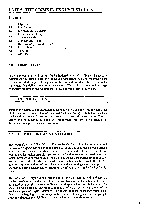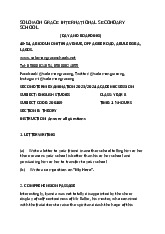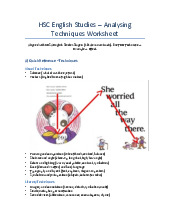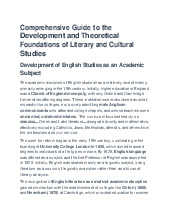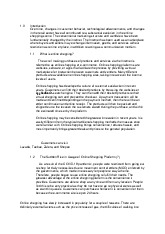




Preview text:
Text and Context
1. Sign: Anything that represents something else
- Signifier: The material representation of the sign (a sound, word etc…)
- Signified: Mental concept evoked by the signifier.
(Representation of a rose is passion
2. Multimodality: Multiple modalities employed simultaneously or in
a sequence (visual, audio, texts). EG: New broadcast requires us to
engage simultaneously with visual texts, both still and animated,
written text scrolling across screen and a soundtrack.
3. Given-New Axis: Example of visual grammar. Western influenced
media tend to place what is “given” on the left and what is “new” on
the right, EG: Before and after pics.
- We read the transition from the left to the right picture in terms of temporal progression.
4. Ideal-Real Axis: The top of a picture tends to represent the ideal
and the bottom the real. EG: Advertisements tend to put the
promise at the top and the factual info at the bottom.
5. High/Low Modality: Modality refers to the reliability of or truth-
value of a message. Reliability is largely determined.
- In linguistics, modality often relates to auxiliary verbs such as
“might”, “must”, “should” and so on…
- “It might rain”- Low modality (not necessarily true)
- “It will rain”- High modality
- Western traditions of visual texts= Photographs seem more “true” than cartoons.
6. Actors and Goals: Actor corresponds to the subject of a grammatical sentence.
- In a picture of a man shooting a deer w a rifle, the man is the
actor, and the deer is the goal. W/ both in the pic, the pic is
transactional. When only the actor is present, the pic is non- transactional.
- The actor is the agent that instigates movement in the pic.
- When a vector is formed by a gaze (someone looking at
someone), the person who is looking can be referred to as the
reacter and the participant (deer) is the phenomena.
- In other words, where the gaze forms a prominent vector, we
refer to reacters than to actors and to phenomena rather than goals.
7. Carriers and Attributes: Some pics do not depict actions but
rather represent larger concepts through carriers and attributes.
- EG: A pic of an Afrikaaner farmer in a textbook w the label “The
people of South Africa” would fulfil the role of a carrier in the
sense that he simply represents the supposed “attributes of a particular type.
8. Vectors (Reacters and Phenomena): Natural lines formed by the composition of a picture.
- In transactional pictures, vectors are like verbs: The represent an action.
- EG: A picture of someone diving into the water, the line linking
the diver to the water is the vector, while the diver is the actor
(reacter), the water is the goal (phenomena)
- In a pic where someone is looking directly at us, the vector is
linked to the viewer and we can say there is a “direct address”.
9. Framing, Anchoring, Juxtaposition: All pictures are compelled to
frame the reality they depict and the location of the frame will be based
on the intention and location of the producer.
- When a pic has a caption, or some sign that explains it to us, we
talk about anchoring: In other words, the range of possible
meanings of the pic is restricted
- Various forms of media use juxtaposition to create an effective meaning.
- Juxtaposition can be temporal (one image following another) or
spatial (diff images placed in relation to one another Binti
Binti is a black Bildungsroman- It follows the growth and development of
the main character from childhood to adulthood. It is their coming of age /
Psychological and moral growth of a character from childhood to adulthood.
Structures and systems, however, make it difficult for Binti to come of age bc they are Anti-Himba.
The only way Binti can come of age is through progressive loss and
disembodiment, i.e, losing her culture, people. Land and a complete transformation. Binti’s world
1st Himba person to attend Oomza University.
Himba people are closely tied to their land, and they refuse to leave.
Otjize on her hair and body have healing powers.
Why black representation matters:
Binti has come to terms with the oppression and racism she faces from
the Khoush . She is labelled as the “Dark Other” according to Thomas (2018).
Okafor presents the Himba people are an evolved tribe, making them
artisans and mathematical geniuses, who make astrolabes for the Khoush
(acts as interstellar cell phones).
Coloniality, difference, violence
Colonial rhetoric: Himba= (Africans) are oppressed. Khoush= Colonizers
Khoush refer to the Himba as “dirt bathers”
Binti’s journey represents the anxieties and opportunities for the
immigrant in the African Diaspora: leaving behind everything she knows for a foreign environment.
By the Meduse stinging Binti and changing her appearance, they become
the colonizers as they’ve taken away her otjize covered locks. They have
stripped her of her Himba identity, guaranteeing that, even if she returns
home, she will always be marked as an outsider. Subject of Death: Binti describes 2 deaths:
1st: when she left home. Loss of family, land and culture
2nd: At the hands of the Meduse- Death of her body.
Parallels immigrant culture: They find that they can never fully fit in with
the new culture, however, that new culture changes them enough that
they also do not fit in when they return home. Objects in Binti Astrolabe
- Acts as an interstellar device
- Helps Binti Navigate through space
- Establishes the mathematical genius of her people. It is a way
which her life is made bare and legible . EG Travel security reads her like a book. Otjize
- Ties Binti to the land
- Source of identification and comfort Edan
-Manipulates matter and energy, enabling them to perform magic. Readings
Migrations: A Meridians interview with Elif Shafak
Migrations and Belonging- binti feeling like a outsider on the shuttle
-Shafaks life is marked by migrations (born in France, migrated to Turkey,
Spain, Germany), fosters a sense of non-belonging
- feels like an outsider in both turkey and abroad, rejectinf fixed national or religious identities.
Critique of Nationalism – khoush believing that they are superior.
Nationalism: idea expressed by people that believe their nation is superior to all others
Critiques the Turkish for suppressing cultural diversity.
Shafak identifies as a woman of color.
Bintis dark skin vs khoush womens pale skin.
How my grandmother ceased to be African- Shivani Somaiya
-The South Asian community marginalized as foreign despite generations
of integration, reflecting struggle for belonging(Binti faces similar challenges at Oomza Uni.
Binti’s journey involves asserting her Himba identity while embracing her culture
- The grandmother defies stereotype by empowering women and supporting her community
- Binti challenges stereotypes by excelling academically and being a harmonizer w/ the Meduse.
- The coca-cola bottle in the essay serves as a link between community and memory.
- The edan and otjize anchor Binti to her heritage while facilitating connections w others.
Mother Tongue -Amy Tan
- Tan’s mothers language serves as a cultural artifact embodying
her Chinese Heritage and immigrant experience.
- Otjize and the edan anchor Binti to her roots and facilitate connection w/ others (Meduse)
- In mother tongue, language is a tool for connection and a site of
struggle against prejudice. Tan’s mastery of both englishes
empowers her to tell her mothers stoery authentically
- Binti’s role as a harmonizeer allows her to resolve conflict and
assert agency- Power of communication.
